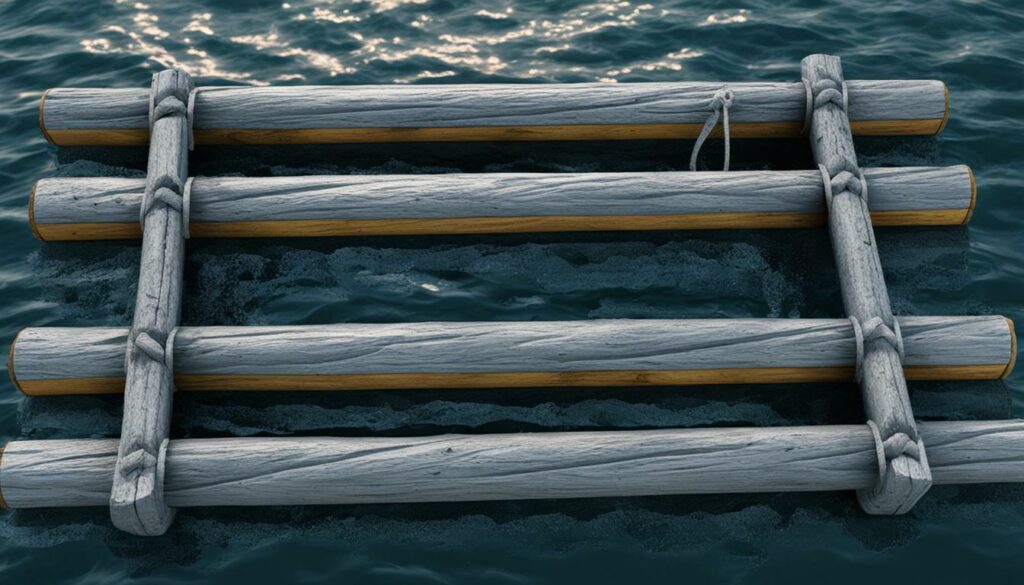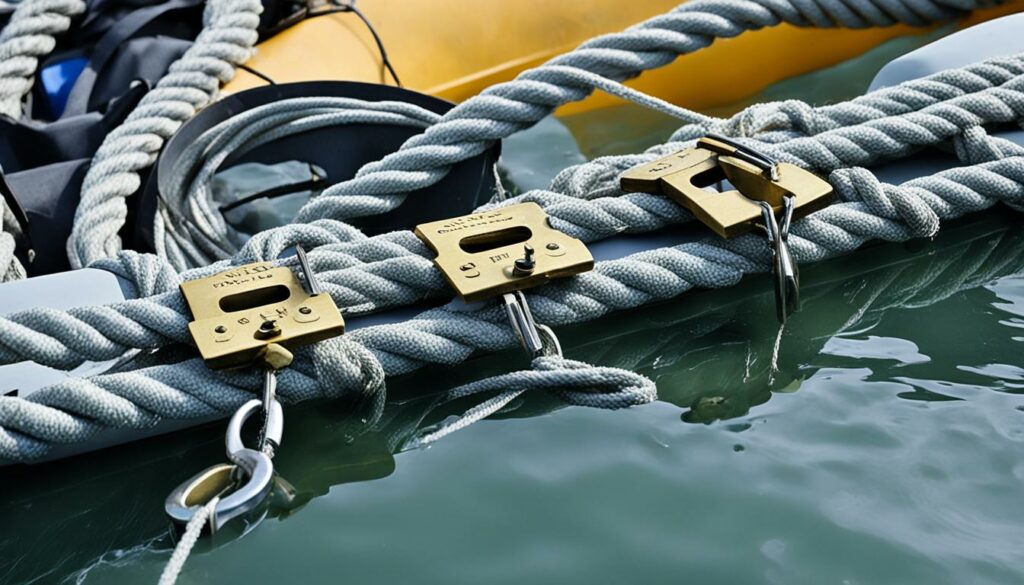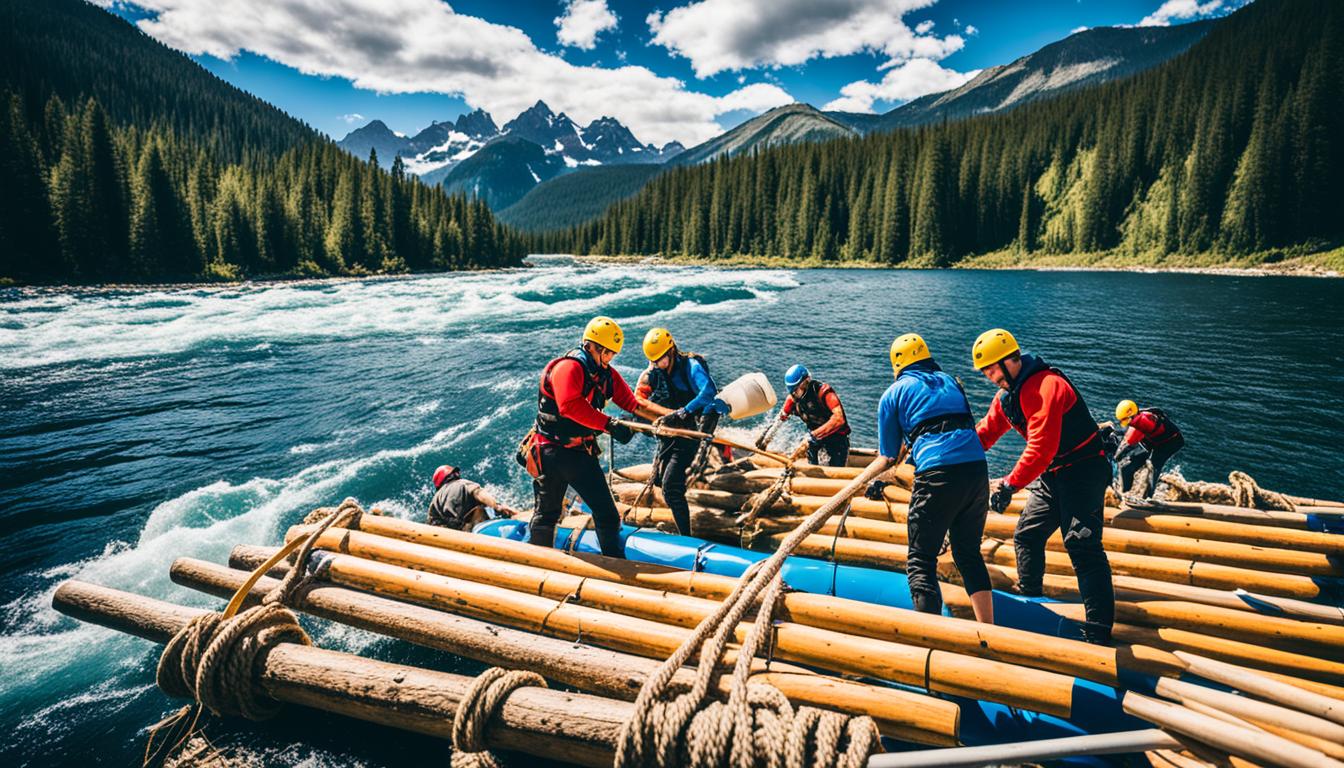Mastering Survival Raft Construction for Emergencies
Survival raft construction is a critical skill for anyone exploring the outdoors or preparing for emergencies on the water.
This step-by-step guide walks you through building a sturdy, reliable raft using simple materials like logs, ropes, and tarps.
Whether you’re a bushcraft enthusiast or simply want to boost your disaster readiness, mastering the art of survival raft construction ensures you can stay afloat, navigate to safety, and even signal for help during unexpected situations.
With the right tools and knowledge, you’ll be prepared to handle water-based emergencies like a pro.
Key Takeaways
- Learn the definition and purpose of a survival raft
- Understand the importance of survival rafts in emergency situations
- Discover the essential materials and tools required for raft construction
- Follow step-by-step instructions on how to build a sturdy survival raft
- Explore safety precautions and essential gear for water-based emergencies
What is a Survival Raft?
A survival raft is key in outdoor survival and emergency plans. It’s light, buoyant, and made for quick shelter on water. Its main job is to keep people safe until help arrives or they can get to land.
Definition and Purpose
A survival raft is a vital emergency tool. It’s crucial for wilderness rescue and keeping safe on the water. It’s a must-have for outdoor lovers and those near the coast. It can save lives in boat troubles, natural disasters, or falls into the water.
Importance in Emergency Situations
Survival rafts are vital for disaster readiness. They can be a lifeline in emergencies. They offer shelter, keep you afloat, and boost your rescue chances. So, it’s smart to have one ready, especially if you’re into the outdoors or live by the water.
“A survival raft can be the difference between life and death in an emergency situation on the water.”
Building a survival raft
Building a survival raft needs the right materials and tools. You must pick lightweight, buoyant logs and strong ropes. Also, you’ll need important outdoor gear.
Materials Required
Here are the main materials you’ll need:
- Lightweight, buoyant logs (like cottonwood, poplar, or spruce)
- Durable ropes or lashings
- Tarps or waterproof coverings
- Flotation devices (e.g., life jackets, inflatable cushions)
- Signaling equipment (e.g., flares, whistle, mirror)
Tools Needed
For building your raft, you’ll need these tools:
- An axe or hatchet for cutting and shaping logs
- A saw for precise cutting and trimming
- Rope or string for lashing and securing the raft
- Knot-tying tools (e.g., carabiners, clamps) for strong connections
Choosing the right survival raft materials and raft construction supplies is key. Also, having the right bushcraft tools and outdoor gear is crucial. This way, you can make a strong, reliable survival raft for emergencies.
Step 1: Choosing the Right Location
Choosing the right spot for your survival raft is key. It should be near the water for easy launch and to save effort. The ground should be flat and clear of obstacles for smooth building.
Ideal Spot for Construction
The best spot for building your raft has some important features:
- Close to a water source like a lake, river, or ocean for easy access and launch
- Level ground with few obstacles for a stable work area
- Protected from strong winds or weather that could make building hard
- Easy to get to for materials and tools
- In a spot with good water access for launching and using your raft in emergencies
Choosing the right spot helps make your raft project successful. It makes sure your raft is ready and useful when you need it most.
The spot where you build your raft is very important. Take time to look at your options. Pick a place that helps your emergency prep the most.
Step 2: Assembling the Base
The base of the survival raft is made with logs laid side by side. These logs should be the same size and arranged carefully. This makes the raft stable and strong.
To put the base together, follow these steps:
- Pick the right log raft construction materials. Use hardwood logs or branches of the same size.
- Line the logs up side by side, making sure they fit well and are held in place.
- Use ropes, vines, or other outdoor building techniques to tie the logs together. This makes a strong base.
- Check the base for any gaps or uneven spots. Fix them so the raft is level and stable.
By carefully building the base, you make a strong and reliable survival raft. This raft can handle emergency situations well.
“The key to building a successful survival raft is in the foundation. Take your time and ensure the base is solid and well-constructed.”
– Outdoor Survival Expert, John Smith
| Material | Purpose | Quantity Needed |
|---|---|---|
| Hardwood Logs | Base Construction | 6-8 logs |
| Rope or Vines | Securing the Logs | 20-30 feet |
| Knife or Hatchet | Trimming and Shaping Logs | 1 |
Step 3: Layering the Logs
After setting the raft’s strong base, it’s time to layer the logs. This survival raft layering is key for balance and stability. It makes sure your emergency raft works well.
For log raft assembly, arrange logs so weight is spread out and the raft is strong. Put thinner and thicker logs together in a pattern. This makes it look good and work well.
Balancing and Securing the Layers
Using the right outdoor construction techniques here is important. Place each log to keep the raft balanced. Then, tie them with strong rope. This keeps the raft together when it hits the water.
- Alternate the thinner and thicker ends of the logs to create a balanced structure
- Tie the logs together using durable rope to ensure the raft’s stability
- Maintain a meticulous eye for detail to ensure the survival raft layering is done correctly
Follow these steps to make a strong and emergency floatation device. Paying attention to details and using the right methods is crucial. This way, you’ll have a raft that can save you in an emergency.
Step 4: Adding Railings and Seating
To make the survival raft safer, add railings and a seating area. Survival raft railings help prevent falls in emergencies. They are made from long logs and keep people safe.
The raft seating area is key for comfort and safety. It uses reclaimed timber or logs. This lets people sit safely and securely, adding to the raft’s outdoor safety features.
Reinforcing the Structure
Adding these parts makes the survival raft stronger. Survival raft railings and raft seating improve stability and security. They let people feel safe, so they can focus on survival tasks.

By adding these features, you make the survival raft better. This increases the chances of a successful rescue or reaching shore safely.
Step 5: Rigging the Tent and Flag Pole
To finish setting up your survival raft, you need to put up a tent and flag pole. The tent keeps you safe from the weather. The flag pole is a key way to signal for help. Make sure to use the right poles and ropes to secure them.
Constructing the Survival Raft Shelter
The survival raft shelter is key to your outdoor survival gear. You’ll need these things to make it:
- Waterproof tent or tarpaulin
- Sturdy poles or wooden frames
- Ropes or straps for securing the shelter
Start by putting the tent or tarpaulin over the raft. Use poles or frames to make it stable and waterproof. Then, tie it down with ropes or straps. This survival raft shelter keeps you dry and safe from the weather.
Deploying the Emergency Signaling Device
Having an emergency signaling device on your raft can really help in an emergency. The flag pole is a key part of this. It lets you show a distress signal that can be seen far away.
Make sure the flag pole is attached to the raft and stands upright. Put a bright flag or signal on top. This makes it easy for rescue teams to see you from the air or water.
Setting up the tent and flag pole right makes your survival raft ready for emergencies. Remember, being prepared and paying attention to details is key.
Step 6: Finalizing with Oar Locks
The last step in making your survival raft is adding oar locks. These are key for moving and steering your raft. They help you get through the water and find safety or help in emergencies.
Put the oar locks in the right spots on your raft for easy rowing. This is important when the water is tough. Oar locks let you move the raft forward and steer. They are a must-have for getting through water and finding your way.
Securing the Oar Locks
- Find the best spots on the raft for the oar locks. Make sure they’re spread out and you can row comfortably.
- Attach the oar locks to the raft well, using strong materials to handle the water’s force.
- Try out the oar locks with the oars. Adjust as needed for smooth and effective rowing.
Adding these oar locks to your survival raft lets you move and steer. This boosts your chances of getting to safety and making it through emergencies on the water.
Raft Propulsion and Outdoor Navigation
Oar locks help you move and steer your raft. This is key in tough outdoor settings. It lets you move your raft and get to where you need to go or call for help.
| Feature | Benefit |
|---|---|
| Oar Locks | Efficient propulsion and maneuverability for your survival raft |
| Outdoor Navigation | Ability to steer and change direction in challenging water conditions |
| Water Rescue | Increased chances of reaching safety and calling for help |
Knowing how to use oar locks on your survival raft prepares you for many outdoor and water rescue situations. It boosts your chances of a safe and successful outcome.

Safety Precautions
Building and using a survival raft means putting safety first. You need the right gear and flotation devices for a safe outdoor adventure.
Essential Gear and Flotation Devices
To keep safe on your survival raft, make sure you have these items:
- High-quality life jackets or personal flotation devices (PFDs) for everyone
- Reliable communication devices, like a waterproof radio or satellite phone, for help
- Strong outdoor survival gear, including signaling mirrors, flares, and a whistle, for rescue
- Enough water rescue equipment, like ropes, carabiners, and a throw bag, for emergencies
Think about the raft’s weight limit, the weather, and water dangers. This helps ensure a safe trip. Being safe and prepared lets you enjoy your outdoor adventure.
“Preparation is the key to a successful and safe outdoor adventure. Equipping yourself with the right gear and being mindful of potential risks can make all the difference in an emergency situation.”
Conclusion
Learning to make a survival raft is key to staying safe in water emergencies. This guide will show you how to build a raft that can keep you safe until help comes. It’s a vital skill for anyone who loves the outdoors and wants to be ready for anything.
Knowing how to make a survival raft is important for emergency preparedness and outdoor survival skills. It’s useful for adventurers, water lovers, or anyone who wants to be ready for the unexpected. This skill can save lives in water rescue situations.
Being ready for the outdoors is crucial for survival. Learning to make a survival raft is a big step towards keeping you and others safe. So, start now, get your hands dirty, and become a pro at this important skill.
FAQ
What is a survival raft?
What are the key materials needed to build a survival raft?
What tools are required to construct a survival raft?
What is the importance of choosing the right location for building a survival raft?
How is the base of the survival raft constructed?
How are the logs layered to enhance the stability and structure of the survival raft?
What features are added to the survival raft to further enhance its safety and functionality?
How is the survival raft equipped with shelter and signaling capabilities?
How are oar locks added to the survival raft for improved maneuverability?
What safety precautions should be taken when building and using a survival raft?
Source Links
- How to Build a Log Raft (with Pictures) – wikiHow – https://www.wikihow.com/Build-a-Log-Raft
- How to Build a Log Raft – https://www.artofmanliness.com/skills/how-to-build-a-log-raft/
- A Guide to building a Timber Raft to take on your own River Adventure – http://goingsoloadventure.blogspot.com/2015/08/a-guide-to-building-timber-raft-to-take.html
